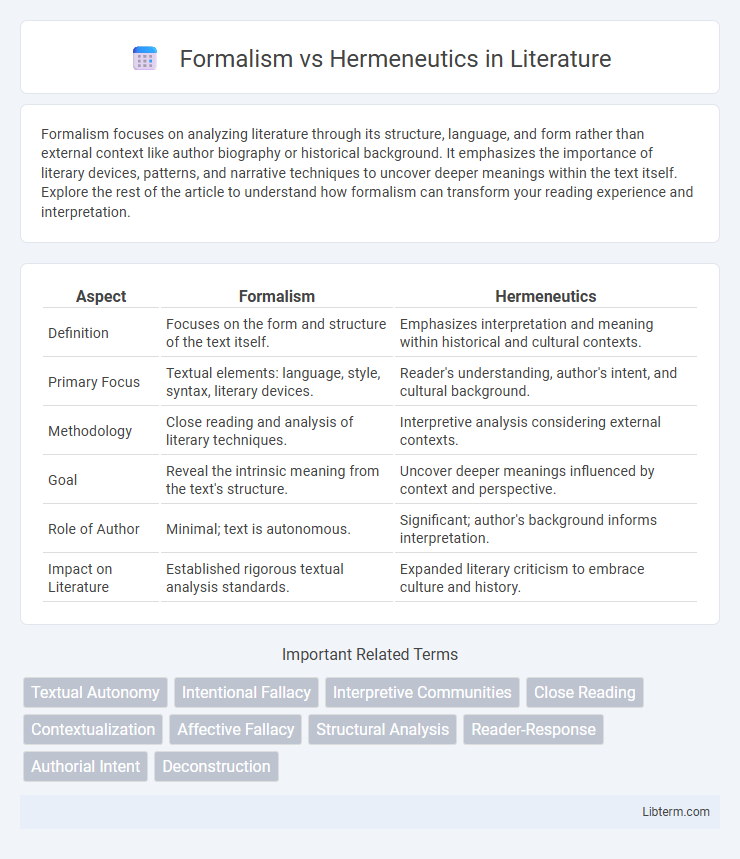Formalism focuses on analyzing literature through its structure, language, and form rather than external context like author biography or historical background. It emphasizes the importance of literary devices, patterns, and narrative techniques to uncover deeper meanings within the text itself. Explore the rest of the article to understand how formalism can transform your reading experience and interpretation.
Table of Comparison
| Aspect | Formalism | Hermeneutics |
|---|---|---|
| Definition | Focuses on the form and structure of the text itself. | Emphasizes interpretation and meaning within historical and cultural contexts. |
| Primary Focus | Textual elements: language, style, syntax, literary devices. | Reader's understanding, author's intent, and cultural background. |
| Methodology | Close reading and analysis of literary techniques. | Interpretive analysis considering external contexts. |
| Goal | Reveal the intrinsic meaning from the text's structure. | Uncover deeper meanings influenced by context and perspective. |
| Role of Author | Minimal; text is autonomous. | Significant; author's background informs interpretation. |
| Impact on Literature | Established rigorous textual analysis standards. | Expanded literary criticism to embrace culture and history. |
Introduction to Formalism and Hermeneutics
Formalism emphasizes analyzing the intrinsic features of a text, such as structure, language, and literary devices, independent of external contexts like author intent or historical background. Hermeneutics centers on interpreting texts by considering historical, cultural, and authorial contexts to uncover deeper meanings and intentions. Both approaches provide distinct methodologies for understanding literature, contrasting structured textual analysis with context-driven interpretation.
Historical Origins of Formalism
Formalism originated in early 20th-century Russia, particularly through the work of the Moscow Linguistic Circle and figures like Viktor Shklovsky and Roman Jakobson. This approach emphasized the intrinsic features of literary texts, such as structure, language, and devices, prioritizing form over historical or biographical context. Formalism's historical roots lie in its reaction against traditional literary criticism that relied heavily on authorial intent and historical background.
Historical Origins of Hermeneutics
Hermeneutics originated in ancient Greek philosophy, particularly with figures like Aristotle, and evolved through theological interpretation during the Middle Ages, emphasizing the understanding of biblical texts. Its historical roots contrast sharply with Formalism, which emerged in the early 20th century, focusing on the structural elements and intrinsic features of literary works rather than historical context. The development of Hermeneutics as a discipline highlights its commitment to uncovering meaning through context, authorship, and cultural background analysis.
Key Principles of Formalist Criticism
Formalist criticism emphasizes close reading and analysis of a text's structure, language, and literary devices without considering external contexts such as author intent or historical background. Key principles include focusing on intrinsic elements like plot, symbolism, imagery, and diction to uncover a text's meaning. This approach values the text as an autonomous entity, where meaning arises from its formal features rather than external influences.
Core Concepts in Hermeneutic Theory
Hermeneutic theory centers on understanding meaning through interpretive processes, emphasizing context, historical background, and the subjective experiences of both the author and reader. Key concepts include the hermeneutic circle, where interpretation involves a continuous interaction between the parts and the whole of a text, and the fusion of horizons, which describes the merging of differing perspectives across time. Unlike formalism, which prioritizes the intrinsic features of a text, hermeneutics prioritizes the dynamic relationship between the interpreter and the text's cultural and historical context.
Formalism: Strengths and Limitations
Formalism excels in its rigorous analysis of literary structures, emphasizing textual elements such as syntax, form, and literary devices to uncover intrinsic meaning independent of historical or authorial context. Its strength lies in providing objective criteria for interpretation, enabling close reading that highlights how language and narrative techniques shape understanding. Limitations of Formalism include its neglect of cultural, historical, and reader-response factors, which can result in an incomplete analysis that overlooks broader socio-political influences on the text.
Hermeneutics: Strengths and Limitations
Hermeneutics excels in interpreting texts by emphasizing context, historical background, and the subjective experience of both author and reader, which enriches understanding beyond literal meaning. Its strength lies in unlocking deeper insights in literature, law, and theology through dialogical engagement with the text. Limitations include potential over-reliance on subjective interpretation, risking relativism and difficulties in establishing universally applicable meanings.
Comparing Analytical Approaches
Formalism emphasizes analyzing literary texts through their structural elements such as syntax, style, and narrative techniques, aiming for an objective interpretation based solely on the text itself. Hermeneutics prioritizes understanding the meaning behind texts by considering historical context, author intent, and reader interpretation, highlighting the dynamic interaction between text and interpreter. Comparing these approaches reveals Formalism's strength in isolating textual mechanics, whereas Hermeneutics offers depth through contextual and philosophical exploration.
Impact on Literary Interpretation
Formalism emphasizes analyzing the text's structure, language, and literary devices to uncover meaning inherent within the work itself, prioritizing objective interpretation. Hermeneutics centers on understanding texts through the context, author's intention, and reader's perspective, highlighting subjective and evolving interpretations. This contrast shapes literary criticism by balancing intrinsic textual analysis with cultural and historical contextualization, influencing how meaning is derived and appreciated.
Contemporary Relevance and Future Directions
Formalism emphasizes structural analysis and intrinsic features of texts, providing robust frameworks for digital humanities advancements and algorithmic text analysis in contemporary research. Hermeneutics enriches interpretative practices by foregrounding historical context, authorial intent, and reader reception, fostering critical approaches in cultural studies and interdisciplinary scholarship. Future directions suggest integrated methodologies leveraging formalist precision with hermeneutic depth to enhance AI-driven literary interpretation and dynamic meaning-making in evolving media landscapes.
Formalism Infographic

 libterm.com
libterm.com